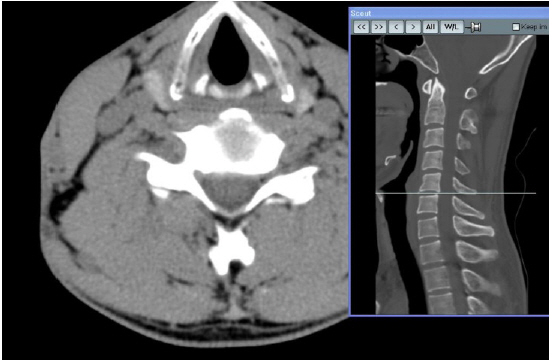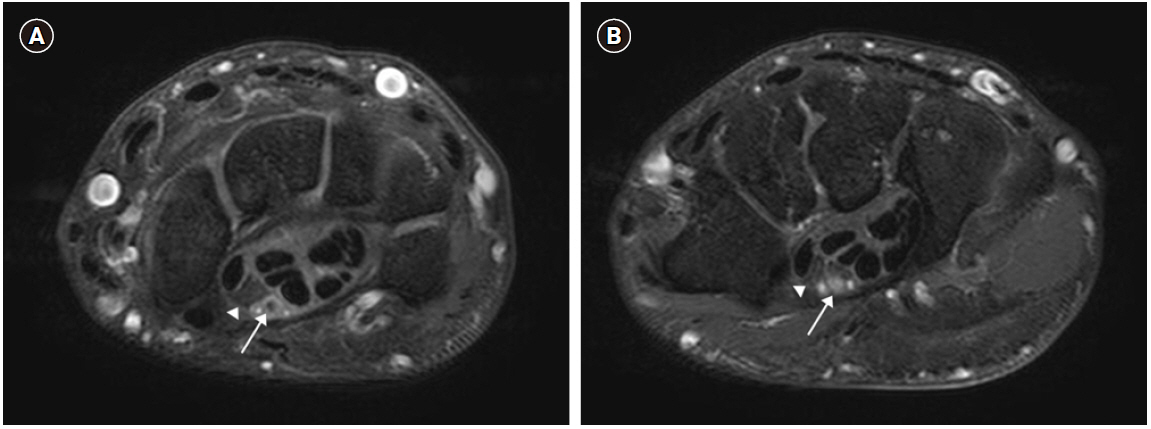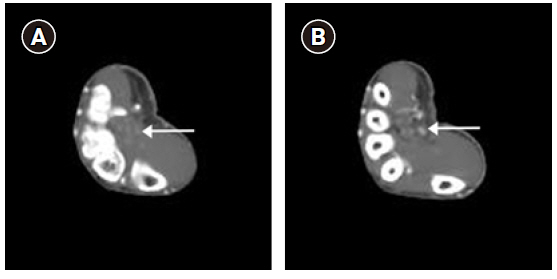Anesth Pain Med.
2020 Apr;15(2):193-198. 10.17085/apm.2020.15.2.193.
Carpal tunnel syndrome caused by thrombosed persistent median artery - A case report -
- Affiliations
-
- 1Department of Anesthesiology and Pain Medicine, Dongkang Medical Center, Ulsan, Korea
- 2Department of Anesthesiology and Pain Medicine, Cheju Halla General Hospital, Jeju, Korea
- KMID: 2500971
- DOI: http://doi.org/10.17085/apm.2020.15.2.193
Abstract
- A rare case of carpal tunnel syndrome caused by a thrombosed persistent median artery is presented here. The diagnosis was delayed due to the overlapping cervical radiculopathy. Acute severe pain and nocturnal paresthesia were chief complaints. Ultrasonography, magnetic resonance imaging, and computed tomography angiography revealed that the median nerve was compressed by the occluded median artery. Instead of surgery, conservative therapy was tried. It worked well for six months. The importance of using modalities for decision making of diagnosis and treatment is emphasized in this report.
Keyword
Figure
Reference
-
1. Ibrahim I, Khan WS, Goddard N, Smitham P. Carpal tunnel syndrome: a review of the recent literature. Open Orthop J. 2012; 6:69–76.2. Kopuz C, Baris S, Gulman B. A further morphological study of the persistent median artery in neonatal cadavers. Surg Radiol Anat. 1997; 19:403–6.3. Singla RK, Kaur N, Dhiraj GS. Prevalence of the persistant median artery. J Clin Diagn Res. 2012; 6:1454–7.4. Dahmam A, Matter-Parrat V, Manguila F, Giannikas D, Marin Braun F. Acute carpal tunnel syndrome due to a thrombosed persistent median artery: unusual cause in athletes. J Traumatol Sport. 2015; 32:126–8.5. Kele H, Verheggen R, Reimers CD. Carpal tunnel syndrome caused by thrombosis of the median artery: the importance of high-resolution ultrasonography for diagnosis. Case report. J Neurosurg. 2002; 97:471–3.6. Srivastava A, Sharma P, Pillay S. Persistent median artery thrombosis: a rare cause of carpal tunnel syndrome. Australas J Ultrasound Med. 2015; 18:82–5.7. Alfonso C, Jann S, Massa R, Torreggiani A. Diagnosis, treatment and follow-up of the carpal tunnel syndrome: a review. Neurol Sci. 2010; 31:243–52.8. Keith MW, Masear V, Chung K, Maupin K, Andary M, Amadio PC, et al. Diagnosis of carpal tunnel syndrome. J Am Acad Orthop Surg. 2009; 17:389–96.9. Upton AR, McComas AJ. The double crush in nerve entrapment syndromes. Lancet. 1973; 2:359–62.10. Seok JH, Lee JH, Sim KS, Ban JS, Lee JH, Kim EJ. Overlapped multiple distal entrapment neuropathies hindering diagnosis of thoracic outlet syndrome −a case report−. Anesth Pain Med. 2012; 7:348–51.11. Altinkaya N, Leblebici B. Prevalence of persistent median artery in carpal tunnel syndrome: sonographic assessment. Surg Radiol Anat. 2016; 38:511–5.12. Gassner EM, Schocke M, Peer S, Schwabegger A, Jaschke W, Bodner G. Persistent median artery in the carpal tunnel: color Doppler ultrasonographic findings. J Ultrasound Med. 2002; 21:455–61.13. Feintisch AM, Ayyala HS, Datiashvili R. An anatomic variant of persistent median artery in association with carpal tunnel syndrome: case report and review of the literature. J Hand Surg Asian Pac Vol. 2017; 22:523–5.
- Full Text Links
- Actions
-
Cited
- CITED
-
- Close
- Share
- Similar articles
-
- Thrombosed Persistent Median Artery with Bifid Median Nerve Causing Acute Carpal Tunnel Syndrome: A Case Report
- Thrombosed Fusiform Dilatation of Persistent Median Artery with Normal Median Nerve
- Carpal Tunnel Syndrome Caused by Persistent Median Artery and Bifid Median Nerve in an Adolescent
- An Unusual Cause of Carpal Tunnel Syndrome: A Case of Tuberculosis of the Median Nerve
- Revision Surgery after Carpal Tunnel Release for Idiopathic Carpal Tunnel Syndrome







